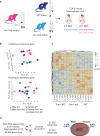A Transcriptomic Dataset of Embryonic Murine Telencephalon of Fmr1-Deficient Mice
- PMID: 40456813
- PMCID: PMC12130245
- DOI: 10.1038/s41597-025-05104-7
A Transcriptomic Dataset of Embryonic Murine Telencephalon of Fmr1-Deficient Mice
Abstract
Fragile X syndrome (FXS) is a neurodevelopmental disorder caused by mutations in the fragile X messenger ribonucleoprotein 1 (FMR1) gene. FXS patients exhibit autistic behaviors and abnormal brain structures, with notable sex differences. However, the mechanisms by which Fmr1 deficiency leads to these sex differences during brain development remain unclear. In this study, we performed bulk RNA sequencing on telencephalon samples of Fmr1-knockout mice of both sexes at embryonic day (E) 14.5, i.e., at the peak of neurogenesis. Clustering analysis revealed gene expression differences influenced by Fmr1 gene dosage and sex. We found that majority of the transcripts were shared between male and female sample groups, while a smaller number were unique to each sex. Our dataset underscores the importance of studying brain development during the embryonic period to detect sex-dependent genetic factors which contribute to neurodevelopmental disorders.
© 2025. The Author(s).
Conflict of interest statement
Competing interests: The authors declare no competing interests.
Figures


References
-
- Hunter, J. et al. Epidemiology of fragile X syndrome: A systematic review and meta‐analysis. Am J Med Genet A164, 1648–1658 (2014). - PubMed
-
- Eliez, S. Brain anatomy, gender and IQ in children and adolescents with fragile X syndrome. Brain124, 1610–1618 (2001). - PubMed
-
- Freund, L. S. Chromosome Fragility and Psychopathology in Obligate Female Carriers of the Fragile X Chromosome. Arch Gen Psychiatry49, 54 (1992). - PubMed
Publication types
MeSH terms
Substances
Grants and funding
- JP21wm0425003/Japan Agency for Medical Research and Development (AMED)
- #JP24wm0625311/Japan Agency for Medical Research and Development (AMED)
- 19H03318/MEXT | Japan Society for the Promotion of Science (JSPS)
- 24K02203/MEXT | Japan Society for the Promotion of Science (JSPS)
- #16H06279 (PAGS)/MEXT | Japan Society for the Promotion of Science (JSPS)
LinkOut - more resources
Full Text Sources

